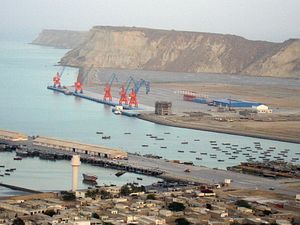China’s President Xi Jinping came to Pakistan bearing serious cash this week, pledging to invest $46 billion in their neighbor’s fragile infrastructure on Monday. Much of that money will go toward the China-Pakistan Economic Corridor (CPEC). It’s a mix of roads, rails, and pipelines that will connect Beijing’s infrastructure at Gwadar Port in Balochistan, just off the southern tip of the Persian Gulf, with Xinjiang province on China’s western frontier, some 3,000 kilometers away. That will do much to enrich a relationship that Pakistan’s Prime Minister Nawaz Sharif once described as “sweeter than honey.” It also gives China a direct route by land to the Indian Ocean basin, the site of 70 percent of the world’s oil traffic.
If enacted, that plan would enable China’s naval vessels and merchants to bypass the Malacca Strait, long a haven for pirates and militants who prey on unsuspecting ships. The CPEC would allow the government and banks in the mainland to lend to Chinese companies operating in Pakistan, facilitating construction along the route. Some of the other line items in the deal aim to fix Pakistan’s failing energy infrastructure: the CPEC calls for $15.5 billion in investments ranging from coal to solar and hydroelectric power, scheduled to become part of Pakistan’s national electricity mix in 2017. That will follow a fiber optic cable linking Xinjiang and Rawalpindi, which will come at the cost of $44 million.
China has plenty of incentive to unleash a spigot of investment, despite fears that Pakistani radicals are stoking violence in Xinjiang among the 10 million Uyghur Muslims that live there. Beijing has already pushed heavily for other projects in the region, including the 1,240 km Karachi-Lahore motorway, a six-lane, high speed corridor expected to be completed in the fall of 2017, and orchestrating upgrades to public transportation, including metro and bus service, in six cities, including Lahore, Karachi, and Rawalpindi. Modernizing the Karakoram highway, which runs 1,300 km from Kashgar, the ancient silk road crossing in Xinjiang, all the way into the heart of the Punjab, Pakistan’s biggest province, will also prove critical.
All of that leads to Gwadar, which China hopes to transform into a free-trade zone on the order of a Singapore or a Hong Kong, another major focus for Chinese investors. That carries geopolitical weight. China’s aid to Pakistan now exceeds American spending, which has totaled $31 billion since 2002. Washington’s investments have slowed since counterterrorism funding authorized by Congress during the Afghan surge has dried up.
It’s not as though China isn’t interested in military issues. President Xi also used the occasion to finalize a deal to send eight submarines to Pakistan, in a long-promised deal. They’re also working to get on shared ideological ground: the Research and Development International think tank (RANDI), will be chaired by Pakistani and Chinese leaders. That unfortunate acronym became the butt of plenty of Twitter jokes on Monday. But the group could wield serious influence, especially in thinking up plans to help Pakistan fight terror and potentially determining the role of mediators in talks with the Taliban in neighboring Afghanistan.
China’s grand plan for Pakistan’s infrastructure has taken shape over the course of President Xi’s visit. It will have a major impact on what the future holds for Islamabad, and the entire Indian Ocean basin.

































